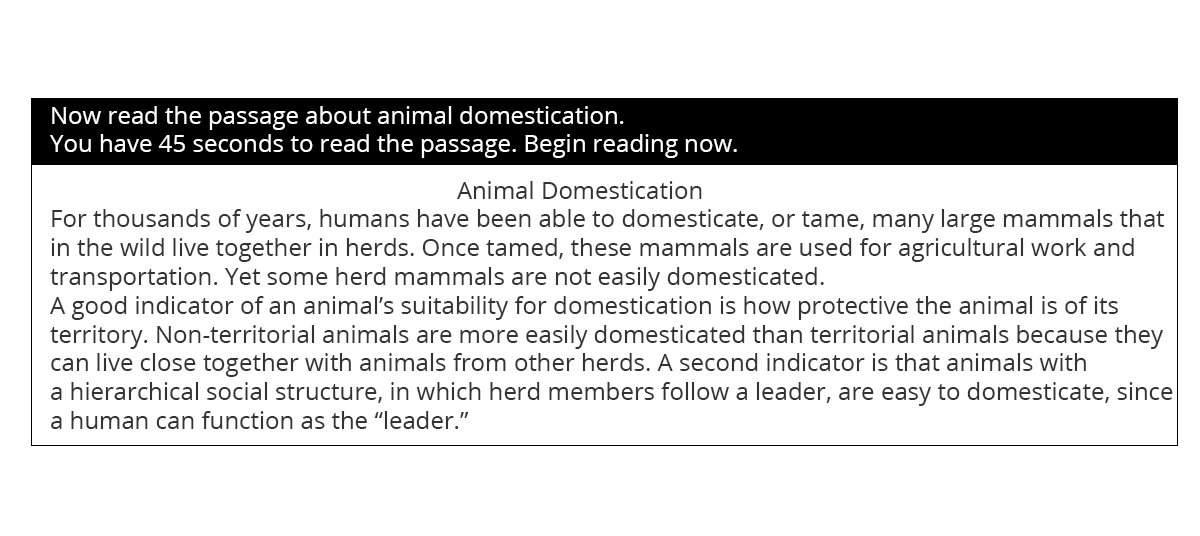Speaking is often the most stressful part of a language test. Not only does a candidate have to think on their feet, jump from topic to topic, control their accuracy, make sure they use a range of grammar structures and vocabulary, but also interact with the invigilator/examiner and sometimes a partner. On the other hand, however, one just needs to know the types of tasks, the requirements, what is expected from you on the test day to get the highest score possible for their current level of abilities and skills, and in this respect the Speaking Section of TOEFL iBT is no different. So, what to expect?
General Information
- The Speaking Section takes approximately 20 min, with 6 speaking tasks.
- You will be given 15 or 30 seconds to prepare for each task, and 45 or 60 seconds to give your answer. There will be a timer on the screen to help you manage your response.
- There is no examiner, invigilator, or a partner to interact with – your answers are just recorded on the computer and will be assessed later.
- Some of the questions ask for a response to a short reading passage, a talk and/or a lecture. Your answer should be based on the information in the listening and/or reading passages.
- You can take notes throughout the Speaking section and use them while providing your responses.
- Typically, a good response is supposed to take all the time provided and to be complete by the end of the response time.
General recommendations:
- There is no examiner, so it might be a little bit less stressful
- All responses are quite short, which means you must focus on organization and structure of your spoken answers to make sure you are able to develop the topic sufficiently
- You definitely need to train yourself to perform within the time limits of the test to know how much you can do in the given preparation time and response time
- You should learn how to take notes while listening to base your answer on those
Question 1
1. You will be asked to speak about a personal experience, e.g. a person, a place, an object or an event.
2. You will need to:
- Describe the experience
- Explain the reason for your choice
3. You’ll be given 15 sec to prepare and 45 sec to answer.

Recommendations:
- Take notes during 15 sec to help yourself concentrate and to structure your talk. For example:
Teacher of Physics at high school
— Engaged everyone
— Motivated by example
— Was fair and funny
- Give 2-3 specific reasons, introduce each with some linking words. For example:
— There are a number of reasons why I admired her. The main one probably was that…. Another reason for my respect to this teacher was… Finally, she was…
Question 2
1. You will be asked to speak about a personal preference and make a choice between two options.
2. You will need to:
- Choose one of the options
- Explain the reason for your preference
3. You’ll be given 15 sec to prepare and 45 sec to answer.

Recommendations:
- Jot down some notes during 15 sec to help yourself concentrate and to structure your talk. For example:
Individually
- Aware of personal learning style
- Easier to organize (place, time)
- No time wasted on chatting and having fun
- Always choose 1 option, begin with stating your opinion, and then give several clear reasons and/or examples.
Question 3
1. You will be given 45 sec to read a small text about some campus-related issue. Then you’ll listen to two people discussing the same text for about a minute. Usually, one of them will have a strong opinion about the ideas in the reading passage.
2. You’ll have 30 sec to prepare and 60 sec to speak.
3. You’ll have to:
- Summarize the situation (reading) and opinion about it (listening)
- Explain the reasons the speaker had for their opinion in relation to the text


4. DO NOT give your own opinion about reading/listening passages.
You will then hear:
Man
Oh great, now we have to come up with more money for next semester.
Woman
Yeah, I know, but I can see why. When I first started here, classes were so much smaller than they are now. With this many students, it’s hard to get the personal attention you need . . .
Man
Yeah, I guess you’re right. You know, in some classes I can’t even get a seat. And I couldn’t take the math course I wanted to because it was already full when I signed up.
Woman
And the other thing is, well, I am kind of worried about not being able to get a job after I graduate.
Man
Why? I mean you’re doing really well in your classes, aren’t you?
Woman
I’m doing ok, but the facilities here are so limited. There are some great new experiments in microbiology that we can’t even do here . . . there isn’t enough equipment in the laboratories, and the equipment they have is out of date. How am I going to compete for jobs with people who have practical research experience? I think the extra tuition will be a good investment.
Recommendations:
- As you read, pay attention to WHAT has been proposed/changed/planned and WHY
- As you listen, figure out if the speaker supports or opposes the ideas in the reading passage and why
- DO take notes of the reasons for the speaker’s opinion given in the audio, e.g.:
— Woman agrees with the announcement
— It’s right to increase the fees
— Too many students in the classes, no personal attention
— Not enough / old equipment
— Practical experience / job prospects? - Connect the speaker’s opinion to the reading. Begin with the brief outline of the text (“City University has just announced that… because…”), and then describe the speaker’s opinion (“The woman supports the idea… as she has experienced… Э)
- Rephrase the ideas from the text and the audio whenever possible, do not just repeat what the prompts had.
Question 4
1. The format is very similar to Question 3, only this time the text and the audio will be about an academic subject.
2. You will be given 45 sec to read a text, then you’ll listen to a professor talking on the same subject. Usually, the audio will either give a specific example of the concept from the text, or provide a contradictory point of view.
3. You’ll have 30 sec to prepare and 60 sec to speak.
4. You’ll have to:
- Connect listening and reading passages
- Explain how the example supports the concept OR contrast the two views


5. DO NOT give your own opinion about reading/listening passages.
Then you will hear the lecture:
Professor
So we’ve been discussing the suitability of animals for domestication . . . particularly animals that live together in herds. Now, if we take horses, for example . . . in the wild, horses live in herds that consist of one male and several females and their young. When a herd moves, the dominant male leads, with the dominant female and her young immediately behind him. The dominant female and her young are then followed immediately by the second most important female and her young, and so on. This is why domesticated horses can be harnessed one after the other in a row. They’re “programmed” to follow the lead of another horse. On top of that, you often find different herds of horses in the wild occupying overlapping areas—they don’t fight off other herds that enter the same territory.But it’s exactly the opposite with an animal like the uh, the antelope . . . which . . . well, antelopes are herd animals too. But unlike horses, a male antelope will fight fiercely to prevent another male from entering its territory during the breeding season, OK—very different from the behavior of horses. Try keeping a couple of male antelopes together in a small space and see what happens. Also, antelopes don’t have a social hierarchy—they don’t instinctively follow any leader. That makes it harder for humans to control their behavior.
Recommendations:
- As you read, try to focus on the general concept presented
- As the lecture is usually more specific, figure out the general connection between the two: theory and example, theory and counterexample, theory and its application, problem and successful solution, etc.
- Take notes while listening and you’ll only hear the excerpt once
- Start with describing the main concept from the reading, then move on to how the lecture is related to it. For example, begin with saying “According to the text, herd animals can be easily domesticated provided that …”, after that refer to the audio “The professor exemplifies this theory by comparing horses to antelopes. The former …, while the latter…”
- Use your own words whenever possible, do not just repeat what you read/heard
Question 5
1.You will be asked to listen to a conversation (60-90 sec long) about a campus-related situation.
2. You will have to
- Describe a problem and proposed solutions
- Express your opinion
3. You will be given 20 sec to prepare and 60 sec to give your response.

Then you will hear the conversation:
Man
Hey Lisa, how’s it going?
Woman
Hi Mark. Uh, I’m OK, I guess, but my schoolwork is really stressing me out.
Man
Yeah? What’s wrong?
Woman
Well, I’ve got a paper to write and two exams to study for. And a bunch of math problems to finish. It’s just so much that I can’t concentrate on any of it. I start concentrating on studying for one of my exams, and then I’m like, how long’s it gonna take to finish that problem set?
Man
Wow. Sounds like you’ve got a lot more work than you can handle right now. Look, have you talked to some of your professors . . . I mean, you know, try to explain the problem. Look, you could probably get an extension on your paper, or on the math assignment . . .
Woman
You think? It would give me a little more time to prepare for my exams right now.
Man
Well, I mean another thing that you might do . . . I mean have you tried making yourself a schedule? I mean that’s what I do when I’m feeling overwhelmed.
Woman
What does that do for you?
Man
Well, I mean it helps you to focus your energies. You know, you make yourself a chart that shows the next few days and the time till your stuff is due and . . .
Woman
Uh-huh . . .
Man
I mean think about what you need to do and when you have to do it by. You know then start filling in your schedule—like, all right 9:00 to 11:30 A.M., study for exam. 12:00 to 3:00, work on problem set. But I mean don’t make the time periods too long. Like, don’t put in eight hours of studying—you know, you’ll get tired, or start worrying about your other work again. But if you keep to your schedule, you know you’ll just have to worry about one thing at a time.
Woman
Yeah, that might work.

Recommendations:
- You’re supposed to first describe the problem that the speakers were talking about, then state what solution you prefer and why, e.g. “The female student is under a lot of stress at the moment due to the fact that… Her friend suggested either … or… I believe asking for an extension might be a better option, as it may give you…”
- The reasons for your preference can be based on the audio as well as on your own experience
- Use 20 sec to make notes, especially about the reasons for your choice
Question 6
1. You will listen to a brief excerpt from an academic lecture first.
2. You’ll have to
- Summarize the main points made in the lecture
3. You will have 20 sec to prepare and 60 sec to speak.

The professor will then begin the lecture.
Because the United States is such a large country, it took time for a common national culture to emerge. One hundred years ago there was very little communication among the different regions of the United States. One result of this lack of communication was that people around the United States had very little in common with one another. People in different parts of the country spoke differently, dressed differently, and behaved differently. But connections among Americans began to increase thanks to two technological innovations: the automobile and the radio.
Automobiles began to be mass produced in the 1920’s, which meant they became less expensive and more widely available. Americans in small towns and rural communities now had the ability to travel with ease to nearby cities. They could even take vacations to other parts of the country. The increased mobility provided by automobiles changed people’s attitudes and created links that had not existed before. For example, people in small towns began to adopt behaviors, clothes, and speech that were popular in big cities or in other parts of the country.

As more Americans were purchasing cars, radio ownership was also increasing dramatically. Americans in different regions of the country began to listen to the same popular radio programs and musical artists. People repeated things they heard on the radio—some phrases and speech patterns heard in songs and radio programs began to be used by people all over the United States. People also listened to news reports on the radio. They heard the same news throughout the country, whereas in newspapers much news tended to be local. Radio brought Americans together by offering them shared experiences and information about events around the country.
Recommendations:
- Make sure you are taking notes while listening – you’ll need them for your response. Pay attention to specific terms, classifications, categories, examples, stages in the process, etc.
- Use your own words whenever possible
- DO NOT give your own opinion
- Use a variety of linking words to connect your ideas, to introduce examples, justifications and opinions.
Finally, here are some key phrases that a TOEFL candidate might find useful for the Speaking section.






 Анна Тетерина
Анна Тетерина 
 Анастасия Юферева
Анастасия Юферева 


